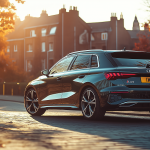Test drive: Honda Insight 1.3 EX Hybrid CVT 105g/km




















The TotallyMotor Verdict
The Honda Insight features the type of hybrid tech that we’re probably the most used to right now; a small petrol engine teamed up with a battery-powered electric motor. It’s the same power-principal used in the most famous of mass market hybrids, the Toyota Prius – a car with headline eco-figures of 89g/km of CO2 and 72.4mpg claimed combined fuel efficiency, and a basic list price of £21,055.
While this Insight TotallyMotor test car is the most expensive in the range at £20,995, the Insight range starts at £16,995 for the entry-level SE model. Honda quote the SE eco-figures at 101g/km of CO2 and 64.2mpg combined; figures that we can see are beaten by the Prius, but not by much, and look at the price difference between the two cars; £21,055 for the Prius and £16,995 for the Insight.
Sure, so the Prius squeezes some extra frugality from its more efficient hybrid system, looks to go a little further between fill ups and ducks the London congestion charge with its sub-100g/km CO2 rating, but both cars are free from road tax, forever.
Can the Insight live up to its quoted frugal figures and, perhaps less importantly than dodging the forecourt; does it feel like a normal hatchback and forget it’s a hybrid…?
Test drive: Honda Insight 1.3 EX Hybrid
First impressions:
The Insight shares the familiar, aerodynamic hybrid body shape with a fairly traditionally-shaped front-end, a quick-slopping-to-the-rear roofline and a very flat rear-end. This the low-drag shape that currently dominates this type of hybrid car.
For more traditionally-styled hybrid cars, take a look at our Toyota Auris hybrid and Lexus CT 200h reviews, or for a little more funk, check out our Honda CR-Z “sports hybrid” review.
Up front with the Insight, we’ve got a recognisable Honda family face featuring a 3-bar, almost solid, silver grille, flanked by angular, inner-detailed headlights. It’s pretty plain sailing around the rest of the Insight with clean, high shoulders, 16-inch, 7-spoke alloy wheels and a split tailgate nestled between two large, triangular LED-filled taillights.
This is the top-of-the-range EX model, priced at £20,955 OTR, and as such features a cleanly colour-coded exterior and tinted rear privacy glass, while extra attraction comes in the way of Spectrum White Pearl pearlescent paint, costing an extra £440.
Into the interior:
Inside the Insight is where we see more of the top-trim price coming to the fore, and there’s a good chunk of comfy standard equipment for your Insight EX cash.
The (perforated) leather seats look and feel great, offering plenty of every-direction-adjustment for me – including height adjustment – to get happily comfortable and supported; matching the wide rage of adjustment in the modern-looking and premium-feeling steering wheel.
That steering wheel is kind of packed with command buttons, but we always expect lots of modern tech from Honda, and while the driving position was good for me, I did notice quite a width to the A-pillar, and the rear window’s split-bar running across the rear view mirror view takes a little getting used to.
Other items of standard EX comfort and fun equipment include heated front seats to take the nip off on winter mornings, paddle shift gear selectors – that I used only once – and a CD/MP3/FM radio audio system with voice recognition DVD sat-nav and Bluetooth connectivity.
Front space is plentiful for the two front-sitters and three adults can travel out back, but it would be a little tight for bigger people, and there’s that sharply-slopping aero-roofline to consider if they’re six-foot or more. The boot is averagely-sized at 408-litres; rear seats up.
The multicoloured, multi-function, eco-encouraging dashboard is definitely an Insight item of note, with its futuristic Japanese flavour. It’s very nearly as groovy as the Honda CR-Z’s dash.
In general, I found the Insight’s inner space to be comfortable and well appointed with a premium touch and feel around the cabin, and that familiar Honda-techno-edge.
The drive:
Medium-size cars with small engines – it’s a 1.3-litre, 87bhp petrol engine up front in the Insight – connected to automatic (CVT) transmissions can suffer a little in the speedy stakes when compared to the same car with a manual transmission. But this is an eco-car with a hybrid-automatic-transmission (that manages the early up-shifting); so speed is not the focus, here.
The Insight’s petrol engine is backed up by an electric motor that adds a further 13bhp to the power party but, more crucially, an extra 58lb ft of torque to the engine’s torque output of 89ft lb. That’s 100bhp and 147ft lb of torque.
Together still these aren’t huge performance figures – Insight will reach 62mph in 12.5secs and pull on to a 113mph top speed – but at the start of your acceleration journey is where the early torque-shove of the electric motor makes the best impression.
Pulling away from busy junctions is a quick and clean affair thanks to the immediate forward shove from the electric motor, that makes it’s full chunk of torque at just 1000rpm, and by the time the petrol engine comes on torque-song at 4500rpm, you’re already well on your way.
Push the Insight hard on a full power acceleration to 70mph and the small petrol engine makes a fair shout about things, whereas you won’t hear a peep out of the electric motor. But, with frugality in mind, it makes more sense just to cruise the Insight to your destinations, keeping on an eye on the in-dash eco-meter that rewards a light right foot with higher mpg figures. Honda quote 61.4mpg for their Insight and I averaged around the 50mpg mark during a week of regular (busy) commuting, some motorway cruising and some around-town nipping.
In most situations, once the petrol motor has settled and your speed is attained, the Insight is a quiet cruiser, with motorway speeds retuning minimal engine revs and minimal road and wind noise.
Insight’s steering is light and crisp and while braking performance is strong – backed up by the latest quick-braking software – you might notice a little drag on the rear wheels as the energy recuperation system harvests its energy.
I personally prefer a firmer ride and in that respect the Insight felt just like a “normal”, quite firmly sprung hatchback, and thanks to its relatively lightweight battery / electric motor system, I didn’t notice any adverse effect on the suspension that more weighty battery pack set ups can have.
I didn’t feel urge to drive the Insight hard; it’s just fun – and makes more eco-sense – to drive it in a manner that befits its eco-focus, and maximise those miles-per-gallon.
Ten second sum up:
With our tested fuel economy hovering around the 50mpg mark – up there with the best eco-diesels – succinct Honda techno-styling, a pleasant interior space and “normal” car driving traits, the Honda Insight – especially looking at the cheaper, entry-level pricing, is a believable real-world hybrid option that stacks up well against the competition, especially when it comes to the buying price.
Prices and availability:
The Honda Insight range starts at £16,995 OTR for the entry-level SE model, rising to £20,995 for the top-spec EX model. Price as tested, £20,995, for the 1.3 EX model, plus £440 for the Spectrum White Pearl pearlescent paint seen here. Available now.
Words & pics: Daniel Anslow
Follow us @TotallyMotor
blog comments powered by Disqus


































